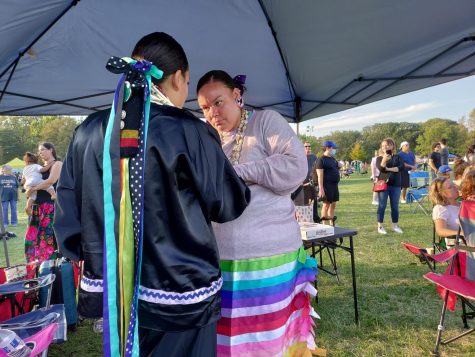68th Annual Chicago Powwow invites tribal reunion, educates non-natives
October 15, 2021

Aaliyah Begay’s pink regalia stood out at the 68th Annual Chicago Powwow. The dance style, Northern Traditional, chosen for its tranquility, corresponds with her dress. Begay made her regalia by hand over two months with the help of her family and wore it at the Powwow. A freshman advertising major, Begay is from the Navajo and Santo Domingo Pueblo nations.
From Oct. 8 to Oct. 10, the Chicago Powwow reunited Chicago Native Americans with other tribes. The celebration included traditional dances such as men’s and women’s Northern Traditional, women’s Fancy Shawl, Jingle Dress and men’s Fancy and Grass dances. The Powwow also included singing, drumming and food, such as Indian tacos, wild rice casserole with buffalo and corn soup.
Ronnie Preston, cultural educator, elder and head judge for men’s dancing at the Powwow, is from the San Carlos Apache, Bear Clan in Arizona. He said most importantly, the Powwow was a chance for non-natives to learn about Native culture.
Chicago’s Public School system celebrated Indigenous Peoples Day on Monday, Oct.11, but Columbus Day is observed by the city of Chicago. On Monday, President Joe Biden officially proclaimed Oct. 11 as Indigenous Peoples Day.
Preston said the Powwow does not have a relationship to the holiday.
“We’re Indigenous people every day,” Preston said.

C. Richard King, professor and chair in the Humanities, History, and Social Sciences Department, includes Native American history in his teaching at Columbia. He said one of the greatest challenges facing the Indigenous community of Chicago is that many Chicagoans are unaware of their existence, making it hard for them to be recognized or have their voices heard.
King said Americans tend to consider the United States as a land of immigrants and are unfamiliar with the term “settler society,” which means taking resources from Indigenous people and establishing permanent residence. King said he has had positive interactions teaching Columbia students these concepts.
The Powwow was an enormous success for Indigenous people, said Mark Denning, the Powwow’s emcee from Muskego, WI, Oneida Nation of Wisconsin.
Despite the Powwow’s success, there is still a concern in the Native American community about the ongoing COVID-19 pandemic. With multigenerational families living together being the cultural norm for many in the community, family elders are especially vulnerable.
“The population is a bit untrusting,” Denning said. “This is because of the harmful track record of the city and U.S. The history stretches back to 1492 … but, as Native people access the halls of power and governance, we’re more likely to hear the voices of folks that look and think like us; in fact, are us.”

Chicago sits on the ancestral land of Native American tribes, according to the American Library Association, including the Council of the Three Fires, which consists of the Ojibwe, Odawa, and Potawatomi Nations, and the Miami, Ho-Chunk, Menominee, Sac, Fox, Kickapoo, and Illinois Nations.
Many Native Americans came to Chicago via a 1950s federal relocation program run by the Bureau of Indian Affairs. The program offered incentives like housing and funding, but in reality, sought to end recognition of Native Americans’ official position as administrators within the infrastructure of the U.S. government.
“You won’t find [The Relocation Act] in the books, that’s part of why our history is also nonexistent,” said Lisa Bernal of the Sisseton-Wahpeton tribe, head judge for the Powwow women’s dancing and program manager for Chicago Public Schools’ American Indian Education program.
Bernal said Chicago’s Native American population does not have anIndigenous presence in an official capacity, and no ownership of dedicated land in the State of Illinois, making the cultural education of Native American students in the Chicago public school system critical.
“You only know about the wars that happened and then really, the Americans don’t put a lot of that stuff in books, because then it makes them look some type of way, right?” Bernal said.

Begay said the need to illuminate Chicago Native Americans is necessary. She said throughout school growing up she was bullied daily by white students who asked if she lived in a teepee or why Native Americans dislike whites.
At Columbia, Begay found the diversity she was looking for. On social media, Begay realized some students knew the meaning of Orange Shirt Day, recognizing child deaths in Canada’s First Peoples’ residential school systems.
“I was really shocked because … [Columbia students] are aware there is Native American stuff going on in the world,” Begay said.
King said Columbia students also have a good understanding of and commitment to the discussion about egalitarianism and human rights, despite attending the U.S. school systems that neglected to teach much about Native American history from a Native perspective.
“Native American people, we have to deal with a lot of things. In the urban setting; it is getting the Native culture out there,” Preston said. “I think Chicago is hurting for it, and I am very excited to be part of the Chicago area … and share some of my great stories in my singing, in my dancing, with the Native community here in Chicago, and I think that is the biggest thing for Chicagoland area with every culture, not just Native.”







